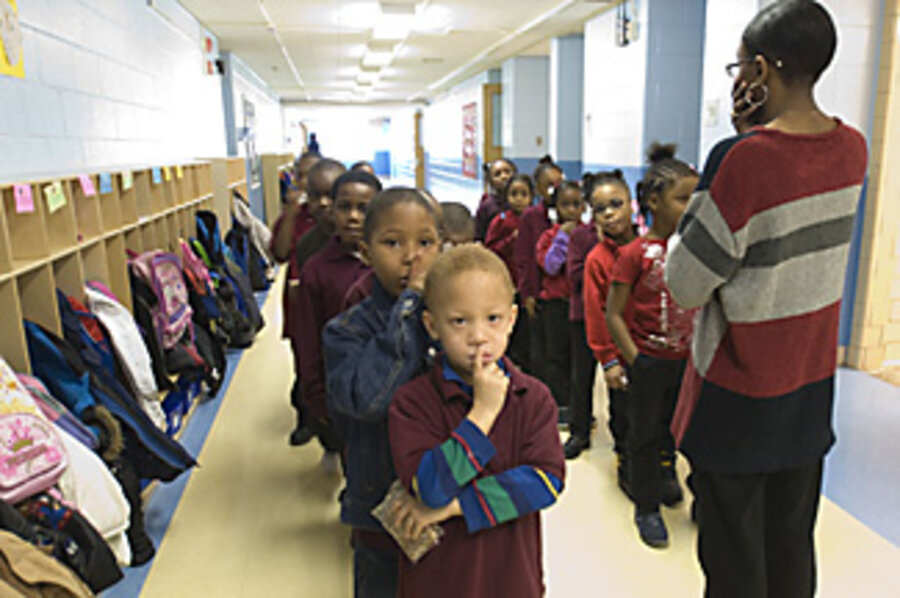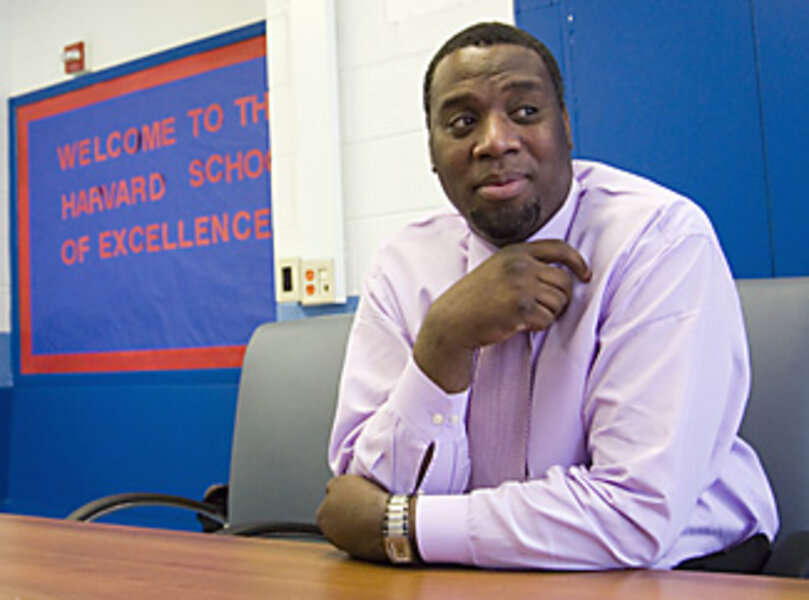Chicago looks to 'turnarounds' to lift failing schools
| Chicago
It looks like a typical day at a typical American grammar school: Students proceed in single file down hallways, a class of fourth-graders listens to their teacher read aloud, and students in another class work in small groups on independent projects.
But Andre Cowling, the tall, imposing new principal of Harvard Elementary on Chicago's South Side, shakes his head in wonder at it all. Last year, he says, "this wouldn't have been possible."
Harvard is one of several public schools here to get a top-to-bottom housecleaning in recent years – including replacing the principal and most teachers – in a bid to lift student achievement out of the nation's academic basement. The drastic approach is known as "turnaround," and Chicago is embracing it more than any US city, though it's unproven and is controversial among teachers, many parents, and students.
"It's risky in that it's new and has an untested track record," says Andrew Calkins, senior vice president at Mass Insight, a nonprofit group focused on school reform, and coauthor of a report on turnaround schools. "It's logical in that the other choice is to keep on doing what's been tried before, and we know what the results of that will be. What you try to do if you're Chicago is to minimize the risk and maximize the possibility of a good outcome" by thinking through everything that's needed to improve the climate for learning at a school.
As Principal Cowling sees it, the risk paid off. Until Harvard Elementary went through turnaround, the school was like "Beirut," he says – 50 kids running through the halls at any time, holes in the floors and peeling paint on the walls, fights on or near campus, no order in the classrooms.
"Now, you can tell it's a school," Cowling says.
For an encore, the city is proposing simultaneous turnarounds at eight Chicago schools in the fall: four high schools and four elementary schools that feed into them. Even for a city that already leads the nation in school-reform ideas, the proposal is unusually bold and sweeping. Districts across the US – many with schools facing reconstitution requirements under the No Child Left Behind law – are watching with interest.
"We want to give families the opportunity to have a high-performing option in the neighborhood throughout [a student's] entire education," says Alan Anderson, director of the Office of School Turnaround for Chicago public schools. "There are a handful of schools that just aren't progressing at the rate we'd like them to," he says. "We know we need drastic change. It's not a decision we take lightly."
The eight schools slated for turnaround are among the worst performers in the district: At the high schools, an average student misses at least 35 days of school a year, dropout rates are above 10 percent, and the passing rate on state tests hovers at about 10 percent.
Still, some families wonder whether this will be just another reform that disrupts their kids' lives and replaces teachers they've grown close to, but yields no change in the quality of the education.
Teachers, of course, are upset about a reform that requires a school's entire staff to be let go, even if teachers can reapply.
"What kind of instability are you creating for children coming from environments that are challenging and already have instability?" asks Marilyn Stewart, president of the Chicago Teachers Union. "You're having to recruit and train teachers, and then have another turnover. No industry can survive that kind of turnover of personnel."
Ms. Stewart suggests a less drastic reform, already undertaken in several Chicago schools with some promising results, in which the principal is replaced, but not the teachers.
"We're not resistant to change," she says. "But we're resistant to this kind of upheaval where you're throwing out the baby with the bath water."
Administrators acknowledge the challenge of finding enough high-quality teachers willing to work with poor children in low-performing schools. But recruiting is easier if there's a dynamic principal who can get people to buy into a new mission for a school, they say. It's also one reason Chicago chose a nonprofit, the Academy for Urban School Leadership (AUSL), to manage the turnarounds at several of the schools: the Orr High School campus, made up of three small schools, and two elementary schools that feed into them.
AUSL, which also manages the turnaround at Harvard Elementary, trains and recruits teachers for urban classrooms. Its proposal for Orr, in fact, includes setting up the new high school as a teacher training academy, where mentor teachers would be matched with those just learning.
"Effective teachers want supportive leadership, positive working conditions, adequate resources, and positive interactions with students and parents," says Donald Feinstein, AUSL's executive director. "When you embed that in a school culture and climate, you can attract more effective teachers."
That wholesale staff turnover – giving a new principal the ability to shape who's working for him or her – is the most crucial element to a turnaround's success, says Mr. Calkins of Mass Insight, but it's not the only one. Other key elements are added time for teachers to plan and collaborate, longer school days or school years, clustering turnaround schools so they can learn from one another, local authority over budget and curricula, and support for teachers and administrators from outside the school, such as the district or an outside group like AUSL.
At Harvard Elementary, Cowling had the whole school repainted, moved his office so he was more visible to the older kids, separated the seventh and eighth grades into single-gender classes, and has the teachers work together for five weeks in the summer to map out the school year and start on the same page.
He ended up rehiring just three of the school's original teachers and hired 17 AUSL-trained teachers.
"This wouldn't be possible with the same teachers," he says. "The kids would have come back with new paint, and the pedagogical insufficiencies would still be there."
Cowling, who traded a $130,000 corporate job for a $40,000 teacher's salary several years ago and who knows every child in his school by name, says his students' parents are now many of the biggest supporters of the changes at Harvard. But he acknowledges it was controversial at first.
At a hearing last week on the turnaround proposal for Orr, the district office was packed with teachers, parents, and students, many arguing against the change.
"We are not science experiments," Bianca Davis, a junior at one of the small Orr schools, told the hearing officer.
"On the television, it seemed like you slandered the teachers," added Melissa Winston, a parent, in impassioned testimony. "Society has failed these kids, not the teachers."
That plea to consider the harm to teachers carries little weight with Cowling. The real focus, he says, needs to be on students.
"I hired who I thought would be the very best for our kids," Cowling says. "We have a moral obligation. It took some drastic measures to get this building turned around the way we did."






